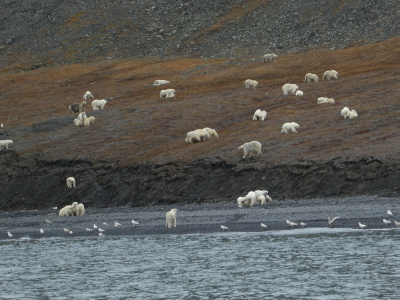Wrangel Island

The Natural System of Wrangel Island Reserve comprises a group of two islands north of the Arctic Circle with a remarkably high diversity of plants and animals.
Wrangel Island and Herald Island lie in the High Arctic Tundra ecoregion, with a very dry and cold climate and a mountainous landscape. The islands were not glaciated during the last Ice Age and subsequently served as a refuge for Pleistocene species that have not survived elsewhere. Biodiversity is high considering its location, with a large breeding Snow goose population, up to 100,000 congregating Pacific walrus and many Polar bear dens.
Community Perspective: Only visited yearly by very few people – Sherry shares the feeling of setting foot on this island.



Map of Wrangel Island
Community Reviews
Sherry Ott
One small step for man and one giant step for mankind is what danced in my head as I set foot on the Wrangel Island tundra and the earth beneath me moved. It was like walking on a sponge, soft and light; almost delicate feeling. However the tundra was anything but delicate. I had just set foot on an island that only a few hundred people have ever seen or walked on. A visit to Wrangel Island is truly a unique once in a lifetime experience.
In fact getting there is the hard part! This is the hard part. You need a special permit to be able to visit the island granted by the Russian authorities. This is not an easy process unless you know someone. However Heritage Expeditions run 3 cruises a summer (in August) to Wrangel Island on their polar vessel, the Spirit of Enderby.
While we visited, 3 Russian rangers came on board our Heritage Expeditions ship and stayed for 4 nights while we made our way around the island. They accompanied us on landings both for educational purposes and for safety purposes. They also showed us images of what life was like for them in the winter which was fascinating. Polar Bears get quite curious in the winter and many visited the ranger buildings quite often. I felt weird when we left them knowing that they had a long cold winter ahead.
Read more from Sherry Ott here.
Site Info
- Full Name
- Natural System of Wrangel Island Reserve
- Unesco ID
- 1023
- Country
- Russia
- Inscribed
- 2004
- Type
- Natural
- Criteria
-
9 10
- Categories
- Natural landscape - Insular Wildlife habitat - Fauna
- Link
- By ID
Site History
2004 Inscribed
2003 Requested by State Party to not be examined
2001 Requested by State Party to not be examined
At Bureau Session
Site Links
Unesco Website
Official Website
Related
In the News
Connections
The site has 30 connections
Damaged
Ecology
Geography
History
Timeline
Visiting conditions
WHS Names
WHS on Other Lists
World Heritage Process
The Plaque
No plaque has been identified yet for this site.